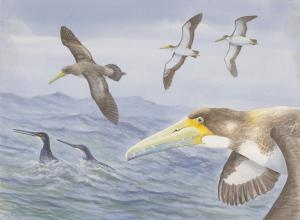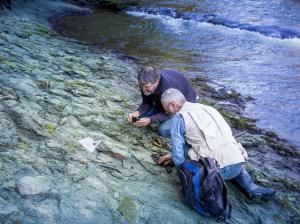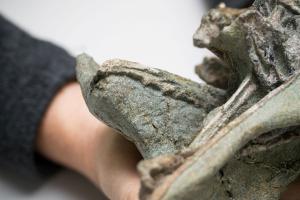Scientists Discover One of World’s Oldest Bird Species at Waipara, New Zealand

Protodontopteryx ruthae. Illustration by Derek Onley. Image Available CC BY NC and for News and Current Affairs Use
Toothed Fossil Find Rewrites History of Seabird Family
Bony-toothed birds (Pelagornithids), an ancient family of huge seafaring birds, were thought to have evolved in the Northern Hemisphere – but that theory has been upended by the discovery of the family’s oldest, but smallest member in New Zealand.
At 62 million-years-old, the newly-discovered 'Protodontopteryx ruthae', is one of the oldest named bird species in the world. It lived in New Zealand soon after the dinosaurs died out.
While its descendants were some of the biggest flying birds ever, with wingspans of more than 5 metres, 'Protodontopteryx' was only the size of an average gull. Like other members of its family, the seabird had bony, tooth-like projections on the edge of its beak.
The seabird fossil was identified by the same team that recently announced the discovery of a 1.6 metre-high giant penguin from the same site.
Amateur palaeontologist Leigh Love found the partial'Protodontopteryx'skeleton last year at the Waipara Greensand fossil site. The bird was named 'Protodontopteryx ruthae' after Love’s wife Ruth. Love wanted to thank her for tolerating his decades-long passion for palaeontology.
Fellow amateur Alan Mannering prepared the bones, and a team comprising Love, Mannering, Canterbury Museum Curators Dr Paul Scofield and Dr Vanesa De Pietri and Dr Gerald Mayr of Senckenberg Research Institute and Natural History Museum in Frankfurt, Germany, described 'Protodontopteryx'.
Dr Scofield says the age of the fossilised bones suggests pelagornithids evolved in the Southern Hemisphere. “While this bird was relatively small, the impact of its discovery is hugely significant in our understanding of this family. Until we found this skeleton, all the really old pelagornithids had been found in the Northern Hemisphere, so everyone thought they’d evolved up there.”
“New Zealand was a very different place when 'Protodontoperyx' were in the skies. It had a tropical climate – the sea temperature was about 25 degrees so we had corals and giant turtles,” he adds.
Dr Mayr says the discovery of 'Protodontopteryx' was “truly amazing and unexpected. Not only is the fossil one of the most complete specimens of a pseudotoothed bird, but it also shows a number of unexpected skeletal features that contribute to a better understanding of the evolution of these enigmatic birds."
Later pelagornithid species evolved to soar over oceans with some species measuring up to 6.4 metres across the wings. 'Protodontopteryx’s' skeleton suggests it was less suited for long-distance soaring than later pelagornithids and probably covered much shorter ranges. Its short, broad pseudoteeth were likely designed for catching fish. Later species had needle-like pseudoteeth which were likely used to catch soft-bodied prey like squid.
Dr De Pietri says “because 'Protodontopteryx' was less adapted to sustained soaring than other known pelagornithids, we can now say that pseudoteeth evolved before these birds became highly specialised gliders.”
The last pelagornithid species died out around 2.5 million years ago, just before modern humans evolved.
The Waipara Greensand site where the 'Protodontopteryx' skeleton was found has yielded several important scientific discoveries in recent years, including ancient penguins and the world’s oldest tropicbird fossil.
Some of these discoveries, including the 'Protodontopteryx' fossil, will be displayed in an exhibition about ancient New Zealand at the Museum later this year.
This research was funded by the Royal Society of New Zealand’s Marsden Fund and is published today in the journal Papers in Palaeontology.
Vicki Blyth
Canterbury Museum
email us here
+64 21 670 250
Visit us on social media:
Facebook
Twitter
Legal Disclaimer:
EIN Presswire provides this news content "as is" without warranty of any kind. We do not accept any responsibility or liability for the accuracy, content, images, videos, licenses, completeness, legality, or reliability of the information contained in this article. If you have any complaints or copyright issues related to this article, kindly contact the author above.


